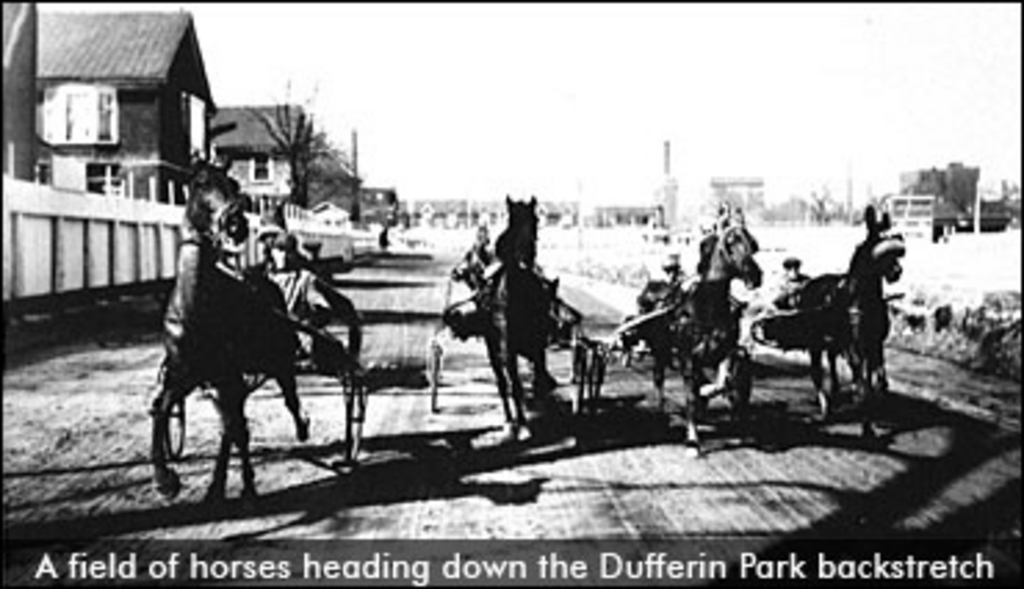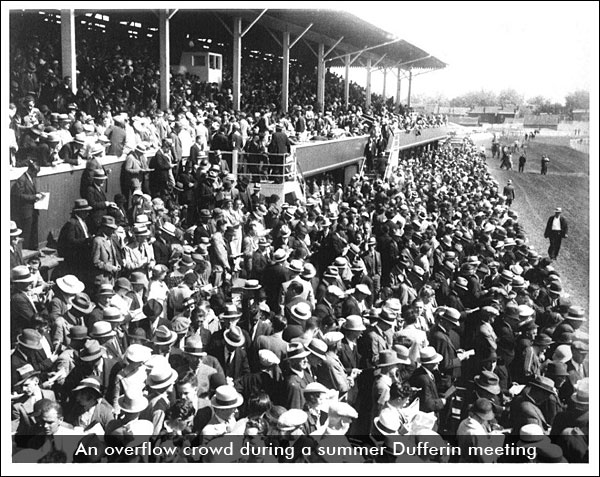
In this week's Rewind Robert Smith recalls the closing of Toronto's fabled Dufferin Park Racetrack
in 1955.
As the fans filed out of Dufferin Park late on the afternoon of Saturday, March 19, 1955 it was a sad day for many. This fabled track had just hosted its last ever day of racing; it would be no more. For as long as anyone could remember, there had been a racecourse on Dufferin Ave., south of Bloor St. Soon it would be demolished and in the years ahead shoppers at the Dufferin Mall would walk where famous horses once trod and where memories were made.
Dufferin Park traces its beginnings back to the late 1800's when the first racing charter was issued to the York Driving and Riding Club. Records indicate that harness racing began there in August of 1907. Part of the original charter included the right to sell liquor, a point that sparked a great deal of controversy in the early years. Many battles over "the evils of gambling and betting" were also fought and eventually overcome. It was one of a number of famous racecourses in the City proper that provided entertainment for horse lovers of both the thoroughbred and standardbred types. Originally owned and operated by the Denison family on land granted by the King, it was purchased for the reported sum of $400 in 1907 by Mr. Abe Orpen, whose son Fred was still on the scene as it closed. Old newspaper accounts showed pictures of the senior Orpen's hat still hanging in the office in 1955, decades after his death. One of the daily rituals observed at the track involved the playing of the national anthem by owner Fred Orpen on the pipe organ.
Often referred to simply as "The Dufferin" it was one of those places that was thought of as an "institution". It had been around forever and somehow people assumed it would always be there. However the proverbial "Powers that be" had decided that the 1955 season would be the final. The rapidly growing City had virtually enveloped the racetrack. Most of the facilities had become outdated and in need of repair or replacement. It was part of a new era in harness racing that would unveil itself over the next few years.
On January 1, 1955 an eight-year-old pacer named Supervisor driven by one of the track's most popular and successful drivers, "Little Joe" Hodgins, rang in the new year. His two-heat win for a purse of $450 also started the countdown to this final day. For many, life would never be quite the same. To this day many tales are told of what was often called "Sufferin' At The Dufferin". It was a haven for tall tales and zany characters and home to the genuine characters of this era. I can recall my late father talking about it and saying that there would just simply never again be a place like it. While Dufferin Park is remembered as the "Capital Of Winter Racing", there were also many summer race meetings held as well, normally just a few days in duration, often in August.

Racing back then was somewhat different than we know it today. Because of the weather, many races were contested over an extremely heavy and slow track. Mile times in the 2:25 to 2:30 range were common with some extremely slow quarters. On March 11th the track must have been a little "sticky" as all 10 heats that day were contested at 1/2 mile. The times ranged from 1:23 to 1:30 1/5. On most days the drivers did not wear their regular driving silks but wore a sort of vest over their heavy winter clothing that carried a number. The fans also "toughed it out" and many huddled near stoves or heaters and in general survived without the creature comforts we have come to know and enjoy nowadays. Undoubtedly the single biggest difference was NO pari-mutuel betting.
The list of those who remember The Dufferin first hand is rapidly diminishing. I have assembled a partial list of the horsemen who competed in that final meeting. I am sure there were many more but to name everyone would be a task beyond my resources. Horsemen from various parts of Canada, representing virtually every province often raced there. Also many U. S.-based stables took advantage of the hospitality offered to them and also used the opportunity to buy and sell their stock. The Dufferin backstretch was widely known for the exchange of horseflesh, even though there were no claiming races. Although not part of the driver's alumni, a very young Bill McDonnell who later served as head of the O.R.C., accompanied his father Thomas on most Saturdays as the senior McDonnell served as a patrol judge.
Here is a portion of the driver's colony; the list does not include those mentioned in the closing day summary below.
Frank Baise, Jack Bannerman, Bob Bomar, Eddie Bradette, Pem Caldwell, Russ Caldwell, Ed Chappell, Don Corbett, Bob Cottrell, Dave Dowson, Phil Dussault, Lionel Ethier, Stan Fife, John Fisher, Oscar Fraser, Forrest Gerry Jr., Jack Gordon, Bill Habkirk, Gardner Hammond, Wm. Harvey, Gerald Hess, Harold Hewson, Joe Hodgins, Almer Holmes, Dick Johnson, Gord Kitchen, Sibley Knott, Honorat Larochelle, Roy Lawson, Frenchie Leboeuf, Marcel L'Heureux, Clarence Lockhart, Vic Lutman, Del MacTavish, Bert Madill, Beryl Manning, Alex McDonnell, Harold McKinley, Hugh McLean, Floyd Milton, Cyril Morrissey, Billy Myrer, Peter Miller, Joe Nero, Allan Pacey, Maurice Pusey, Gordon Ramsay, Al Rogers, Graydon Sheldon, Les Slack, Jim Somerville, Harold Varcoe, Vern Waddell. (See below also)
On the final day of racing, a program of five races each going two heats made up the last ever card of racing. The co-featured races were an Invitational Pace and an Invitational Trot, each carrying a purse of $700. It is very interesting to look at the participants and despite the passage of some 56 years to see so many familiar names. Many are directly related to today's personalities. I have listed the fields for each gait and attempted to show the drivers of each horse as I can best determine.
Invitational Handicap Pace - Purse $700
Two Heats
Nancy Patch (Allan Walker) - 1-1
Jack Brook (Homer Harp) - 4-2
Lee Scott Harvester (Wilfy Hughes) - 2-7
Black Mountain Boy (Henry Portelance) - 7-3
Anna Abbot (Ger. McIllmurray) - 3-8
Bonnie Doon (Keith Waples) - 6-4
Hector Chief (Bud Gilmour) - 5-5
Pastime Lee (Al Washington) - 8-6
Beatty Boy (Percy Robillard) - 10-9
Hal's Bomb (Hugh McLean) - 9-10
Times: 2:28 1/5 (1 mile) -- 2:39 1/5 (1 1/16 miles)
Invitational Handicap Trot - Purse $700
Two Heats
Ginger Up (Keith Waples) - 1-1
Roll On (Percy Robillard) - 2-2
True Silver (H. Harp) - 3-6
Hillcrest Adam (Jacob Geisel Jr. ) - 9-3
Bertha Riddell (Earl Rowe) - 7-4
Victory McElwyn (Theo. Turcotte ) - 6-5
Grattantown (Bob Givens) - 5-9
Josedale Friscowyn (David Claveau) - 8-7
Hall Guy (Max Featherstone) - 10-8
Van Baldwin (Layton Pettigrew) - 4-dnf
Times: 2:28 2/5 (1 mile) -- 2:39 3/5 (1 1/16 miles)


Having recently lost my
Having recently lost my Mother, who also enjoyed success at Dufferin Park - I swell with pride when I see my late Father's name listed to drive in the Invitational Pace. Thank You for the Memories, they mean more now than ever.
Howard
Made my day again Robert.
Made my day again Robert. Many (at least 9) on the list drove for my Dad at Connaught, Richelieu and Blue Bonnets at that time also. Keep the GOOD stuff coming.
i love reading these
i love reading these stories, it would also be nice if you could recall some races which produced Canadian records and other ones from Canada.
In reply to i love reading these by rizkoff
Hey Scott, How
Hey Scott,
How goes it?
It be nice if more photo's existed too, however that's about as likely to happen as the Maritimes becoming the Capital of Harness racing ;)
Robert, As I was
Robert,
As I was digitizing 1954-55-56 issues of Harness Horse magazine, Phil Stewart had explained to me that Dufferin and the last years, were near and dear to his heart. As a result of Phil's request, I digitized the closing months of Dufferin's uncharted results and passed them on to Phil.
In the results from the March 23, 1955 Harness Horse, were contained the Dufferin results from March 7-Mar 16. (if anybody is interested in these, they may contact Phil or myself privately.
On March 10, 1955 at Dufferin, all the heats were at 6.5 furlongs. The opening two heats went in 2:162/5 and 2:234/5.
On March 11, 1955 at Dufferin, all the heats were at 4.0 furlongs (half-mile). The opening two heats went in 1:283/5 and 1:301/5.
These are interesting
These are interesting columns. Someone should compile them and publish them in a book for sale. I love stories about tracks that have been relegated to history. Perhaps a joint book about American and Canadian tracks? This way the history is preserved.
In reply to These are interesting by Pacingguy
Allan, Unfortunately,
Allan,
Unfortunately, it's almost as difficult as "pulling teeth" to accumulate a list of old tracks.
There are even categories?
Pari-mutuel tracks and the earlier Trotting and Driving Parks. There were far more of the later.
Even in the area around Morrisburg, Ontario there were six small tracks within a ten-mile circle.
As an aside, might anybody name all the small tracks around Morrisburg?
The same similarities are the northen-NY Tracks and close to the St. Lawrence Seaway. Many of those tracks in that area, only held-unsanctioned ice races.